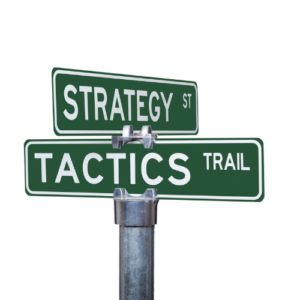28 Sep Death by Tactical Thinking
Why you should make a shift from tactical to strategic thinking
One of my favorite workshops to facilitate is shifting from Tactical to Strategic Thinking.
Without knowing, many leaders, including executives, dedicate most of their scarce time, energy, and other resources to tactical thinking…
I’m not undermining the usefulness of tactics. I’m not lionizing strategy either. We need both!
A couple of things I’ve observed over the year as I interact with participants and engage in one-on-one chats with my clients and coachees. They struggle to:
1. Differentiate the two. It is common to see leaders using strategy and tactics interchangeably. Most of the time, when they talk about strategy, they are actually talking about tactics.
 2. Understand the full scope of strategy. One of the blunders some leaders may unintentionally be making is when they treat strategy as intention, ambition, or slogan. Strategy is bigger and higher than all of these. It must be aligned with the mission and vision of the organization. Strategy leads to practical results that advance the mission of the organization and the realization of its vision. It is not a mere intention, ambition, slogan or even goal.
2. Understand the full scope of strategy. One of the blunders some leaders may unintentionally be making is when they treat strategy as intention, ambition, or slogan. Strategy is bigger and higher than all of these. It must be aligned with the mission and vision of the organization. Strategy leads to practical results that advance the mission of the organization and the realization of its vision. It is not a mere intention, ambition, slogan or even goal.
3. Create synergy between strategy and tactics. Sometimes, an organization may choose a strategy that can lead to victory and winning. However, it may not have cohesive tactics supporting the grand strategy. Every strategy works best with certain relevant tactics. Choosing these tactics dictates whether one achieves success or fails miserably. Making it right when we choose our strategy isn’t enough. We must come up with the right tactics to implement the strategy.
4. Keep the balance. There is no formula for how many percentages of a leader’s time should be dedicated to strategic and tactical thinking. A leader should decide by considering their responsibilities now and where they’re heading in the future. Awareness is key here. One must be aware and then move toward the right mix of strategy vs. tactics.
5. Make a shift intentionally. This is especially common among supervisors and beginner middle managers. Since many of their responsibilities require them to be tactical, they don’t have enough time and energy to be strategic. They don’t go ahead of the curve and develop the necessary strategic thinking mindset and the accompanying skill sets. They don’t carve out time to develop these before they need them at the next leadership level.
Many supervisors, emerging, and middle leaders miss golden opportunities to influence upward because of the lack of strategic thinking. Strategic thinkers get along and work well with executives. The latter are always preoccupied with the greater organization and the big picture. Strategic thinkers know how to pitch, propose, and communicate strategically with decision-makers and get what they want. Do you want to be one of these leaders? If you said yes, then make a shift from tactical to strategic thinking.
Where do you find yourself on the spectrum of Strategic Thinking and Tactical Thinking?
- Are you on the extreme end of strategic thinking? or
- Are you on the extreme end of tactical thinking? or
- Are you balancing the two, and you are in mid-way?
 Remember, no one grade fits all. Depending on where you’re in your leadership and many other factors, you may find yourself in one of these scenarios. Where you’re could be the right place for you and in the NOW. Wherever you may be right now, however, these are some of the questions you should ask:
Remember, no one grade fits all. Depending on where you’re in your leadership and many other factors, you may find yourself in one of these scenarios. Where you’re could be the right place for you and in the NOW. Wherever you may be right now, however, these are some of the questions you should ask:
- Is where I’m now optimal for what I’m doing currently in this leadership position?
- Considering where I’m going in the next few months or years, am I equipped to excel when I get there?
- If there are gaps, how can I bridge these gaps in the next few months?
Hope this helps…
Note: If you have any questions or would like us to arrange a half or full-day workshop or webinar on balancing strategic with tactical thinking, please reach out to our team at [email protected]. Let’s also know if you need similar workshops, such as how to craft your long- and short-term strategic plans. You can also invite us to facilitate your next strategic planning retreat.
